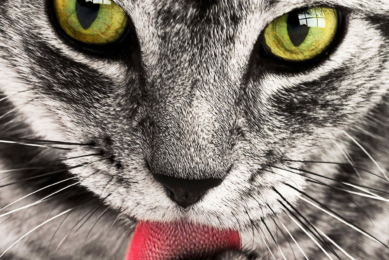Are de-stressing petfoods efficacious?

Our petfood expert Anton Beynen looks at the use of calming supplements in petfoods – do they actually make a difference to your pet?
The marketplace offers food formulas that are advertised as able to relieve stress in dogs and cats. These calming foods contain added L-tryptophan and/or alpha-casozepine as the purported effective substances. Products for dogs are sold in both pet shops and veterinary clinics. Therapeutic foods for cats with idiopathic cystitis may feature de-stressing as a co-treatment.
Effectiveness of calming supplements not proven
High tryptophan intake is thought to increase brain serotonin synthesis, resulting in a better mood in the animal. 4 studies have looked at the impact of supplemental L-tryptophan on the behaviour of dogs with different forms of anxiety. There is 1 published study on cats. Yet the overall outcome can be interpreted as a general lack of support for the effectiveness of additional L-tryptophan for canine and feline stress control.
Also from Anton:
Do high fibre diets stop pets over-eating?
What are the calming supplements
Alpha-casozepine is a decapeptide derived from the tryptic hydrolysis of alpha-S1 casein from bovine milk. It binds to the GABAA receptor and may elicit an anxiolytic effect.
A double-blind study with an anxiolytic drug as a positive control claims that the drug and alpha-casozepine have an equal efficacy in dogs with anxiety-related disorders, but a placebo effect cannot be excluded. A test diet with casein hydrolysate changed various behaviours in dogs, involving both less and more anxiety. In a double-blind, placebo-controlled trial, alpha-casozepine treatment improved social phobias in cats, but the magnitude of the effect is considered insignificant and its reproducibility is unknown.
Study: Dog owners reported immaterial improvement
Therapeutic calming foods for dogs and cats have been put to the test. The foods involved contained added L-tryptophan and hydrolysed milk proteins as the source of alpha-casozepine. In a longitudinal study, a veterinary stress-management food was evaluated in dogs with anxiety-related behaviour problems. The blind-test owners reported an immaterial improvement of anxiety-related behaviour, though a time effect cannot be excluded. In cats, a calming food did not affect plasma cortisol as the index of acute stress or it was ineffective in a human-interaction test.
In a trial using cats with idiopathic cystitis, the intervention involved both a de-stressing food and environmental enrichment, whereas the design was open and non-controlled.
Address the root of your pet’s anxiety
Available research data cannot endorse the efficacy of calming pet foods supplemented with L-tryptophan and/or alpha-casozepine. Irrespective of any of this, the foods do not address the root cause of anxiety. Perhaps behaviour modification and training would be successful.











